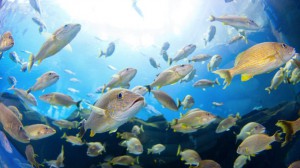Fish Are Food and Friends—US Sustainable Fisheries and Ocean Health

On Wednesday the Center for American Progress (CAP) in Washington, DC, held a talk with leaders in oceans conservation about the effect that US policies on sustainable fisheries have had around the world—and how best practices can be further expanded to help ensure that marine wildlife is conserved globally.
This event coincides with the US State Department’s annual Our Oceans conference, at which President Obama set a precedent by declaring 4,913 square miles of ocean the first national marine monument, protecting centuries-old cold-water corals and deep water ecosystems.
This year is the fortieth anniversary of the passing of the Magnuson-Stevens Fishery Conservation and Management Act, which in 1976 established US jurisdiction over fisheries surrounding the US coastal border up to 200 nautical miles offshore. The Act’s goal was to stop overfishing in lawless waters, pioneering a way of fishery governance that made its way into international law through the United Nations Convention on the Law of the Sea in 1982.
Since then the Sustainable Fisheries Act was passed in 1996 to focus on conservation and ecosystem health.. Using scientific estimates of maximum sustainable yield to set the legal limits on fishing quantities, the act prohibits unsustainable fishing while also making sure that fishermen are supported in times of low supply. In 2006 the Magnuson-Stevens Fishery Conservation and Management Reauthorization Act lent both previous policies a more regulatory and science-based framework by requiring catch quotas for fish species and by enhancing global cooperation on illegal fishing.
Beyond these efforts, panelists at the CAP event and the CAP report on sustainable fisheries have further recommendations on how to improve efforts to enforce sustainable fishing. These include considering the impact of climate change on the oceans in developing fishery policy, as robust and healthy marine biodiversity helps mitigate the effects of climate change; the prioritization of “ecosystem-based management” to consider the impact of catch limits on each species (including ourselves) and on all ecosystems in the oceans; increased funding for data collection that can help inform policy; strict regulations on illegal fishing around the world; and more monitoring over legal fishing vessels.
Importantly, provisions must be made for those who count on their catch for their livelihoods to be financially stable while also aligning with humanity’s longer-term goals of maintaining the biodiversity of our oceans and the health of our planet.
Although promising, let’s hope our work to ensure sustainable fishing isn’t too little too late, as scientists increasingly gather evidence of a sixth mass extinction event, most likely anthropogenic. A recent study suggests that the species most in peril are the larger marine organisms, mostly due to our hunting of their prey and to pollution, destroying their ecosystems at a rate faster than climate change.
It’s clear there is now greater momentum and urgency to heal the damage we’ve caused to Earth before it’s too late. While we often picture rainforests, jungles, and mountains when we think of conservation and sustainability, we mustn’t forget that oceans cover 71 percent of the Earth’s surface, of which we’ve only explored 5 percent. Marine life and ecosystems are integral to the continued prosperity of biodiversity on the planet, and at the very least, to the continued contentment of seafood lovers.
